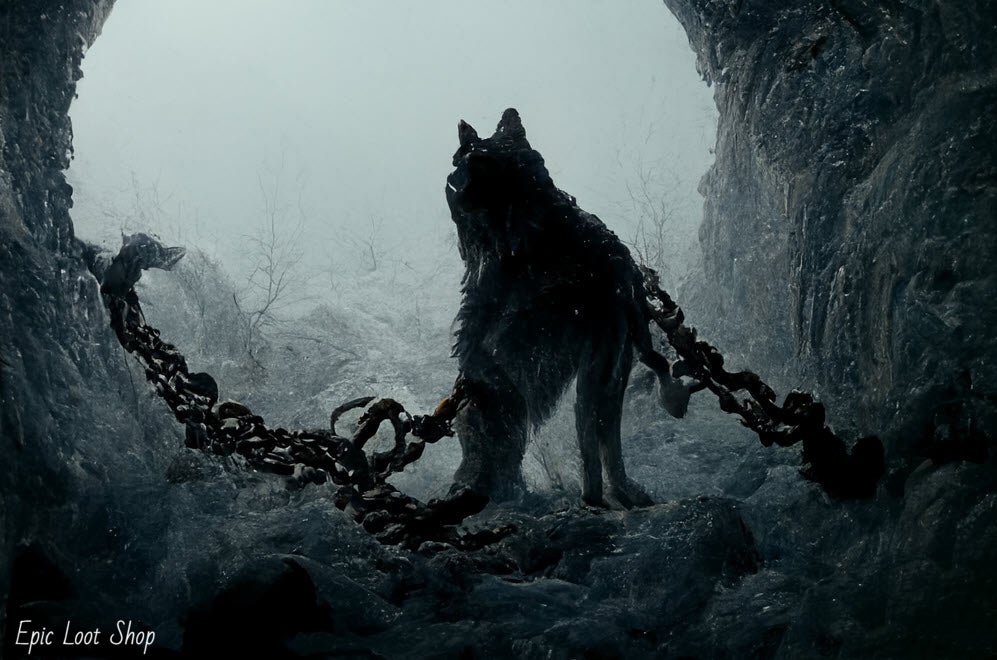Fenrir | The Monstrous Wolf of Norse Legend
Fenrir (also called Fenrisúlfr) was a gigantic wolf in Norse mythology, described as being the son of the demoniac god Loki and a giantess, Angerboda. When Loki had learned that his offspring would be the death of him, he cast the monstrous creature into the water where he was eventually found by the Gods. They took him to Asgard, where he was raised by them to become one of their own. But when Fenrir grew up, it became clear that he was untameable. He bit off the hand of one of the Aesir gods who tried to feed him, and then later broke free from his bonds after attempts to tame him failed.
What powers does Fenrir have?
As a wolf, Fenrir had the typical powers of that particular beast: speed, agility, sharp senses, a good endurance for running and such. But besides his natural wolf abilities, Fenrir had other unique powers as well. One of them was his near-limitless growth. While in wolf form or in any other form for that matter, Fenrir was able to grow without limit. No physical force could stop this growth: no weapon, no magical spell, and no godly power. Even the most powerful gods were helpless in the face of this ability.
What does Fenrir the wolf symbolize?
An ancient manuscript titled Skáldskaparmál (chapter 33) says that Fenrir is symbolic for justice or vengeance. He represents the wild and merciless side of nature, as he does not obey any rules or laws. He is free from all conventions and avenges any slight against him in a very brutal manner. An example is when he bites off the hand of Tyr, the god who tried to bind him with a magic ribbon. This quality may also be represented by his name, since it means “the one who destroys” or “the one who causes destruction” or “the one who will destroy”.
Why did the gods fear Fenrir?
For a long time, the gods of Asgard had been living peacefully in their places. However, they could not enjoy peace for a long time because they feared attack by giants and enemies who had been growing more powerful due to the natural cycle of wars. The gods became afraid of an attack from Fenrir, the wolf. Fenrir was raised among the gods and had enormous size, strength, and power. As Fenrir grew up, he was expected to become stronger than Thor. The gods were afraid that Fenrir would show no mercy to them as he grew bigger and bigger. They were also concerned about how many people would be killed during the battle between Fenrir and Thor. Odin made plans to stop Fenrir from being a threat to the gods before he turned into a monster with exceptional strength.
Is Fenrir stronger than Odin?
They both have their strengths and weaknesses. In one story, Fenrir is bound by a magical ribbon that's impossible to break, but has a hole just wide enough for a finger to fit through. In another, the god Tyr puts his hand in Fenrir's mouth, who then bites off Tyr's hand.
In some stories, Odin is so strong that he can be considered invincible. He rides around on a flying horse with eight legs and can shoot thunderbolts from his spear. Odin also uses magic to transform himself into various animals.
However, in other stories, it's clear that Fenrir is stronger than Odin. Fenrir swallows Odin whole in one story and beats him to death with his own spear in another. In another story, Fenrir breaks free of his bindings and kills Odin and all the gods in Valhalla before being killed by Vidar, Odin's son.
Why does Fenrir have a sword in his mouth?
No one really knows, but there are a lot of theories. One idea is that it's a reference to the sword in Don Quixote, where the sword was stuck in a stone and only the pure of heart could pull it out. In the story of Ragnarok, Fenrir is going to swallow Odin whole at some point (that's why he has a mouth full of swords). If it's just a reference to that, then maybe that means it's meant to be a challenge for someone else to pull the sword out of his mouth. Another idea is that, when Fenrir bites down, it causes an earthquake. If you're familiar with Norse mythology, you'll know that there are a lot of earthquakes associated with Ragnarok. Maybe the swords in his mouth are like fault lines? That's probably the least likely theory though, because there aren't any other mythological characters who talk about earthquakes or fault lines.
Why did Fenrir bite Tyr?
There are a number of theories as to why Fenrir, the great wolf in Norse mythology, bit Tyr, the god of war. Theories range from Tyr being responsible for some of Fenrir's siblings being killed and his other siblings being bound to the earth, to Fenrir simply disliking Tyr for some unknown reason. However, there is one theory that seems to be the most plausible.
In Norse mythology, wolves were considered to be either destructive or constructive forces. They could cleanse the world by eating dead humans and animals, but they also could destroy the world by devouring it's inhabitants; this was particularly true in Ragnarok, when Odin goes into battle with Fenrir and kills him. It is important to note that Tyr was Odin's son and would therefore be related to Fenrir by blood.
Can Fenrir turn into a human?
The question of whether or not Fenrir can turn into a human has been posed before—he is, after all, a shapeshifter. However, in a strictly literal sense, he can't. This is because his turning into another creature requires magic from the god of magic, Odin. The myth explicitly says that Fenrir cannot turn into any creature other than a wolf without magic from Odin.
In fact, there are many examples of this kind of thing in mythology: gods can shapeshift into other creatures, but only with the help of magic. It's part of what makes them god-like—something that mere humans cannot do on their own accord. So if you're wondering whether or not Fenrir could turn into a human without help from Odin, the answer is no—or rather, maybe not.
How did Fenrir escape?
Fenrir escaped by cunning. The dwarves made the fetters strong and light, supple yet unbreakable. Yet they forgot to make them airtight—and so Fenrir's great strength gradually exhausted itself, and he grew smaller and smaller as his breath was used up. He waited as long as he could, then bit off the last of his own tail. At that moment, the dwarves noticed that their work had been breached, and they rushed at him to bind him again—but it was far too late. The wolf had changed size and shape in a single instant, from a wolf into a serpent into a salmon into a fly into a flea, and finally into an ant. The dwarves were unable to catch him again, no matter how hard they tried—and that is why there is no peace between giants and dwarves to this very day.
What was the prophecy of Fenrir?
The prophecy of Fenrir is found in the 13th century Prose Edda, describing it as a primeval being that was "raised by Sinir" and "will be mightiest of all," before biting off its own tail, dying, and causing the world to turn to ice. This cryptic description has been interpreted many ways through history: some have interpreted it as referring to a literal wolf with the ability to consume itself, while others have seen it as a metaphor for the end of the world. Some accounts interpret it as an evil creature that will bring about Ragnarok, but others see it as a necessary part of the natural cycle of life and death. The most common interpretation is that it is a reference to the event that brought wolves into contact with humans for the first time, and therefore led to the domestication of dogs.
Does Fenrir have a symbol?
Some people might say that Fenrir does not have a symbol. If you think about it, though, he does!
Fenrir's son, Skoll, is often seen as the wolf's symbol because of the legend of the sun and moon. When those two celestial bodies were swallowed by Fenrir, Skoll chased the sun while Hati chased the moon. This led to an eclipse.
Given that this myth is often used to symbolize the end of a world, one could say that Skoll is a symbol for Ragnarok. While he stands in for Fenrir in this case, it is still associated with his father.
Culturally, some people see wolves as symbols of war or death. This coincides with Fenrir's role in Norse mythology as well as his role in creating Ragnarok.
Some people believe that wolves are spiritual guardians and messengers from their ancestors. Because of their close connection to their parents, this belief has some roots in how people view Fenrir and his relationship to Odin and Hel.
Perhaps when you think about it a little more, you can find more than one thing that represents Fenrir!
Conclusion
Fenrir is a complex figure, and there are wildly divergent assessments of what his ultimate significance was in Norse mythology. Some see him as a frighteningly dangerous monster who symbolizes the chaos that exists beyond reason and order. Others see him as a tragic figure put on a collision course with the Aesir gods that was heavily facilitated by his father, Loki's, hate for them. However, it is possible to view Fenrir as something of a fulcrum point in Norse mythology; while he may have had some truly awful things to do (such as eating Odin), he did so at the behest of the Aesir gods (who were pretty bad guys themselves).




I adopted a nice, big dog from Romania. He has fierce, yellow eyes, and his ears are not pointy, but half falling down. But still, he is quite wolf-like to me. His real name is Ringo (his name given by Friends For Second Hand Paws, the organisation that saved him from the streets). His first owner called him Chewie (from Chewbacca, from Star Wars), but that man was too weak to handle him. I call him also Chewie, but his special secret name is now Fenrir. Thank you for the interesting story!
Leave a comment